| Mar-01-08 | | Knight13: This is insane. Marshall made a bunch of bad moves. |
|
| Mar-01-08 | | stanleys: <Knight13> Stop spamming man! |
|
| Mar-01-08 | | Knight13: <stanleys> There's a difference between spamming and kibitzing very fast. Anyway, 12...Rg8 and 6...cxd4 isn't that good.
|
|
Mar-04-09
 | | Honza Cervenka: Quite desperate attempt of Marshall to launch Kingside attack which completely failed to materialize. After 21.Bf5! he could have just resign. |
|
| Aug-15-09 | | MarvinTsai: Strange, Lasker always got something to refute Marshal's traps, sacrifices, surprises... through the entire match. |
|
| Feb-07-15 | | poorthylacine: 23. Qxd8+!?: a Capablanca like move!! Winning, even
23.Qg7! was stronger! |
|
| Jan-12-19 | | OrangeTulip: This game reminds me to Monthy Python’s movie ‘the holy Grail’. The scene with the knight who won’t give up the fight despite having lost his legs, his arms, etc. |
|
Oct-24-21
 | | KEG: Lasker had won the first three games of this match, but Marshall had recovered to the extent of drawing seven of the next eight games. Perhaps he was hoping to wear Lasker down. Nothing doing. Beginning with this game, Lasker closed out the match with four straight victories. It had only taken Tarrasch 17 games to rack up eight wins to win his matc against Marshall. With this closing four-game spurt, Lasker did the same in only 15 games. In addition, while Marshall won a game against Tarracsh, he won none in this match against Lasker. This 12th match game nominally lasted 46 moves, but that was only because Marshall played on interminably and inexplicably after he was a piece down in a clearly lost ending. By move 21, if not earlier, Marshall was dead. 1. e4 e6
Marshall played the French Defense in all seven games in which he had Black in this match. He lost four and drew three. Lasker made little effort to do much in these games so on its face the French was not an awful choice, but Marshall might have tried to do something more dynamic if he truly had notions of trying to win the match. 2. d4 d5
3. Nc3 Nf6
Marshall played this in all his games as Black, never trying 3...Bb4, which would seem to be a better fit for his style. 4. Bd3
Lasker also played this in Games 2 and 14 of the match, both of which he also won (although hardly because of this move). He played 4. Bg5 in Games 4,6,8, and 10, drawing three and winning Game 8. The text is rarely played, and seems theoretically inferior to 4. e5 or 4. Bg5. It is, however, entirely playable and was well within Lasker's comfort zone. 4... c5
5. Nf3
Lasker varies here from 5. exd5, his move in Game 2. Janowski preferred 5. cxd5. Either that or 5. exd5 look best. The position after 5. Nf3 was:
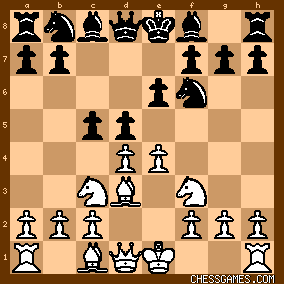
click for larger view5... dxe4
"?"--(Tarrasch)
"This is a mistake because Black gives up the center and also loses a move (instead of developing he brings a White piece still further to the attack)." (Tarrasch) "5...Nc6 was better." (Janowski).
Actually, 5...c4, as Marshall played in Game 14 of this match, is best. The text was poor for the reasons given by Tarrasch. 6. Nxe4

click for larger view6... cxd4
"?"--(Tarrasch)
"To make the same mistake twice, one after the other, may remain something unique in chess literature. Marshall brings a White Knight to the attack without improving his own position in any way.." (Tarrasch). 6...NxN (recommended by Janowski) or 6...Nbd7 were better. 7. NxN+
"?"--(Tarrasch)
Tarrasch's critique notwithstanding, Lasker's move looks best. If instead 7. Nxd4 (the move Tarrasch suggested), Black nearly equalizes with 7...NxN 8. BxN e5!. 7... gxN
"Not 7...QxN ?? 8. Bg5." (Tarrasch),
8. Nxd4
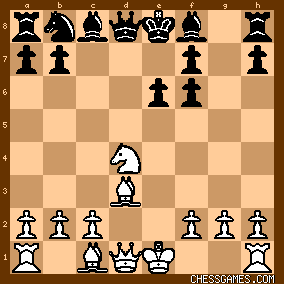
click for larger view"A peculiar position; the seven moves played by Black have left no visible trace on the board, no piece is developed except that which has been exchanged. Black's handling of the opening is therefore weak." Marshall had indeed mishandled the opening. But his position was far from hopeless. But from here, Marshall continued to wreck his position and was probably lost by about move 11, |
|
Oct-25-21
 | | KEG: Post II
8... Bd7
Tarrasch claimed that 8...Qd5 was "much stronger," but after 9. Nb5 Black will be hard pressed to hold the game (since 9...Qxg2? loses to 10. Nc7+ Ke7 11. Rf1 while the superior 9...Qe5+ 10. Qe2 or 9...Qd8 10. Bf4 leave Black in trouble) . 9. 0-0 also is very strong for White after 8...Qd5. Marshall's 8...Bd7, though not all that appetizing, is probably best. 9. Be3 Nc6
10. Be4
"?!"--(Moran)
Janowski criticized the text and preferred 10. c3. But then Black just plays 10...Ne5 with decent play. The text was surely stronger than that. Perhaps 10. Qe2 was simplest and best.
After 10. Be4, the position was:

click for larger view10... Qa5+
"A purely defensive move (Black wants to avoid isolating his c-pawn and therefore prepares for Rc8." (Tarrasch) Tarrasch preferred 10...Ne5, As he shows, White would then lose most of his edge if he played 11. Bxb7 [11...Rb8 12. Bf3 Rxb2 (since the Rook cannot be trapped with 13, Nb3), but in Tarrasch's variation White can just play 11. Qe2 with better chances. Janowski claimed that Marshalll could have obtained the better position here with 10...f5, but after 11. NxN (much better than Janowski's suggested 11. Bf3 bxN (11...BxN 12. QxQ+ is even worse for Black) 12. Bf3 White is clearly better. In sum, Marshall's 10...Qa5+ was probably best. But from this point on Marshall went to pieces and ruined his chances. 11. c3

click for larger view11... Rc8?
Although Janowski called this move "necessary," it probably left Lasker with a winning game. Best was 11...Ne5 with 0-0-0 in view. 11...f5 was also a possibility. 12. 0-0
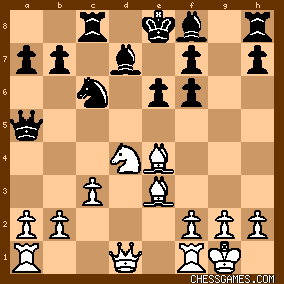
click for larger view12... Rg8
As <Knight 13> correctly notes, this move "isn't good." Black is already in difficult straits.
Moran suggests 12...h5, which looks like a reasonable attempt to shake matters up. Other decent--but not necessarily saving--possibilities were 12...Qc7; 12...f5; 12,,,a6; and 12...Ne5. As my above laundry-list suggests, nothing is all that great for Black here. 13. Re1
"Another of Lasker's excellent defensive moves, which at the same time prepares an attack along the e-file." (Tarrasch). "Preventing 13...f5 because of 14. Nxf5." (Janowski) Lasker could also have snatched the h-pawn on this move, but after 13. Bxh7 Rh8 14. Bc2 Marshall might have had better counterplay than he got in the game after 14. Bxh7. 13... Ne5
13...Be7 offered better chances of resistance. After 13...Ne5, the position was:

click for larger viewCould Lasker now afford to take the Black pawn on h7? |
|
| Oct-25-21 | | RookFile: I know that Steinitz experimented with his king in the center, but probably the rest of us should just castle before playing for tactics. |
|
Oct-27-21
 | | KEG: <RookFile>This game is an example that supports your point. |
|
Oct-28-21
 | | KEG: Post III
14. Bxh7
"The same fearlessness which Lasker has demonstrated previously in this match. E.g., in the second game, with the capture of the g-pawn." (Tarrasch). "There really is no reason whatever why White should not take this pawn. With only one solitary Rook available for the attack, and Black's own King in a dangerous position in the center, White need apprehend no danger from the open file." (Wilson) "?!"--(Moran)
All of the above comments are, in my view, well-founded. As a theoretical matter, the text is fine and probably sufficient to win. But there were other winning ideas (e.g., 14. g3) that would not have given Marshall even the limited counter-play he now gets. Moreover, Lasker could have played 14. Bxb7 and if 14...Rb8 15. b4 Qc7 16. Ba6. The fact that Lasker had all of these likely winning options is confirmation of Marshall's poor handling of the opening. 14... Rh8
15. Be4
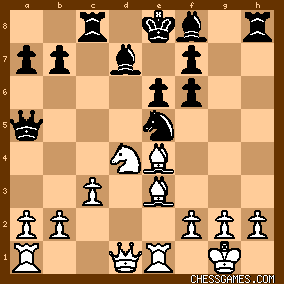
click for larger view15... Qc7
"?"--(Tarrasch)
"Threatens ...Ng5, but the threat is easily parried and Black's attack is repulsed." (Tarrasch) Tarrasch, Janowski, and Moran all claim that 15...Nc4 was best, but only Janowski provided a variation in support. That variation, however was--as Wilson correctly noted--flawed. But Wilson did not supply any alternatives. So let's look at Janowski's (flawed) line: 15...Nc4 16. Bxb7 [White is still probably winning even with this risky move, but White can simply play 16. Qf3! Bd6 (not 16...Nxb2 17. Rab1) 17. g3] 16...Rb8 17. Nc6? now Black wins beginning with 17...Qc7 but White wins with 17. Bc6, a move Janowski ignored. In fact, Marshall's 15...Qc7 was as good as anything (he could equally well have played 15...Qb6. Marshall's problems stemmed from the opening, not from 15...Qc7. 16. Bf4 Bd6
17. Bg3

click for larger view17... Nc4?
This move, not faulted by any of the commentators, was a mistake. Marshall had to think of defense with either 17...Kf8 (with 18...Kg7 to follow) or 17...Ke7 18. Qf3!
"Dr. Lasker now has the attack and a powerful one, too. (Wilson) 18... BxB
19. fxB

click for larger viewMarshall was in trouble here, but the position was sufficiently sharp that Black had at least practical opportunities. 19...Nxb2? would get immediately crushed by 20. Qxf6 and now if 20...Rf8 21. Bc6 BxB 22. Nxe6! is crushing. But Marshall could have fought on with 19...Ke7 or maybe also 19...Rh6. 19... Ne5?
"?!"--(Moran)
After this clunker, the game was over.
20. Qxf6
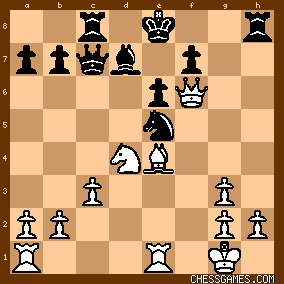
click for larger viewAs I will discuss in my next post on this game, from here Marshall tried a desperado combination that Lasker refuted with ease. In fact, Black is lost here, so Marshall's attempted fireworks made no difference. Marshall seemingly overlooked Lasker's iron defense. |
|
Oct-28-21
 | | KEG: Post IV
20... Rxh2
"?"--(Tarrasch)(Moran)
As Tarrasch pointed out, the Rook cannot be taken because of Ng4+. But Marshall's combination was flawed, as Lasker promptly demonstrated. The only reason I have not joined in the condemnation of Marshall's move is that everything else lost as wekk. The position after 20...Rxh2 was:

click for larger viewWhite to move and win.
21. Bf5
"The simple refutation of [Black's] combination." (Tarrasch) "Obviously this move escaped Mr. Marshall's notice; a piece is now losr." (Janowski) In fact, White has other ways to win (e.g., 21. Rad1; 21. Bc2), but the text was absolutely decisive. After 21. Bf5, the position was:
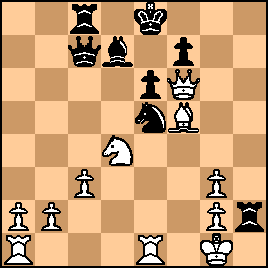
click for larger viewMarshall played on for another 25 moves, but the game was plainly open, especially against so fine a technician as Lasker. 21... Rh5
Hopeless, like everything else.
As Moran noted, 21...Ng4 gets crushed by 22. Nxe6 (or, even stronger, 22. BxN) Rxg2+ 23. KxR Qc6+ 24. Kg1 NxQ 25. Nd4+ kf8 26. NxQ RxN 27. BxB. And if 21...exB 22. RxN+ is murder.
22. RxN Qd8
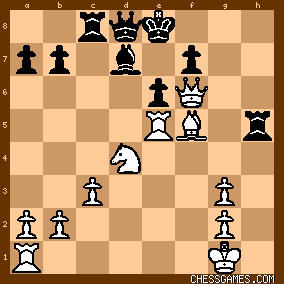
click for larger view23. QxQ+
As <poorthylacine> has pointed out, 23. Qg7 was even stronger. But the text leaves Marshall without a shred of counterplay. Lasker must have been expecting Marshall to resign. After the exchange of Queens, Lasker never gave Marshall the slightest chance to salvage even a draw. But he did not always find the fastest route to victory. 23... KxQ
24. g4 Rg5

click for larger viewTarrasch had a strange explanation for Marshall's decision to continue for another 22 moves here: "...one may surmise that he foresaw the certain prospect of an early defeat in the match and, because Lasker so seldom takes pat in tournaments [Lasker had only played in one tournament between 1900 and 1907--Cambridge Springs 1904--KEG}, feared that he would not soon obtain another opportunity to play with him and therefore wished, probably, to enjoy the experience as long as possible." This seems bizarre, though it is true that between the end of this 1907 match and New York 1924 Marshall only got to play Lasker at St. Petersburg 1914, In any case, I will--for what it's worth-- cover play after 24...Rg5 in my next post on this game. |
|
| Oct-28-21 | | Olavi: <Tarrasch had a strange explanation for Marshall's decision to continue for another 22 moves here: "...one may surmise that he foresaw the certain prospect of an early defeat in the match and, because Lasker so seldom takes pat in tournaments feared that he would not soon obtain another opportunity to play with him and therefore wished, probably, to enjoy the experience as long as possible."> Tarrasch was often very sarcastic in his writings. |
|
Oct-29-21
 | | KEG: <Olavi>Your explanation for Tarrasch's enigmatic comment may be best. With Tarrasch, it is hard to know. Perhaps naively, I gave Tarrasch the benefit of the doubt and assumed he actually meant what he said. |
|
Oct-29-21
 | | KEG: Post V
25. Nf3
This was more than adequate to win.
A faster route to wrapping up the game was 25. Rd1 and if then 25...exB 26. Rd5! Ke7 27. RxB+ ! KxR 28. Nf3+. But with an easy win in hand, the always pragmatic Lasker probably didn't want to risk a miscalculation. 25... Rg7
26. Bd3 Rxg4
27. Kf2
Once again playing slow but steady chess. 27. Rd1 or 27. Nd4 were again faster methods. And yet again, Lasker was doing only what he had to do to close out the game. He may have been expecting Marshall to resign at any moment. 27.... Ke7
28. Rae1 Rcg8
29. Bf1 Bc6
30. b3
Again taking the slow boat instead of 30. Rf5 or 30. Ra5 or 30. Rh5. 30... Rh8
Stiffer resistance might have been offered, but Marshall's situation was so hopeless he can hardly be faulted for trying to find a way for counterplay (assuming he wanted to play on a piece down against Lasker in the endgame. 31. R5e3
Again declining to play 31. Ra5--still a faster route to finishing off what was left of this game. 31... Rhg8
32. a4
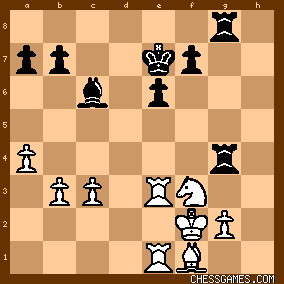
click for larger viewAs is obvious, Marshall hadn't developed any real threats sufficient to warrant playing on against the World Champion. 32... a5
Perhaps 32...Bd5 or 32...Kd8 were slightly better, but these moves, like the text, provided no true hope for Black. 33. Ne5 Rf4+
34. Kg1
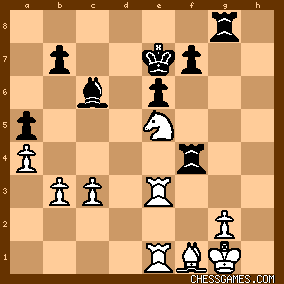
click for larger view34... Be8
Utterly hopeless. With Lasker poised to play Nc4, Marshall (if he wanted to continue) had to play 34...Ra8 or 34...Bd5 After the text, Marshall loses a valuable pawn and gives Lasker two passed pawns on the Queen-side. What followed was a massacre, and--Tarrasch notwithstanding--could not have been any fun for Marshall. 35. Nc4 b5
Pointless. Marshall should have spared himself the rest. 36. axb5 Bxb5
37. Nxa5
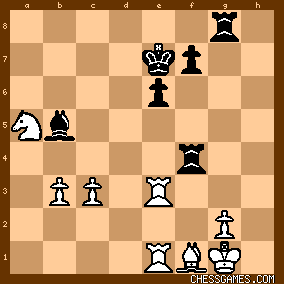
click for larger viewLasker's position was so good at this point he would likely have had a win even without his extra piece. He was probably bewildered--if not insulted-by Marshall's decision to continue. 37... Bd7
38. b4
The passed pawns begin to roll.
38... f5?!
Desperation.
39. Nb3
Lasker could also have played 39. b5 or 39. c4. Was he enjoying his overwhelming advantage too much to finish off the game immediately? 39... Rfg4
40. Nd4

click for larger viewThe White Knight was now a multi-headed monster. But Marshall played on. I will cover the inevitable finale in my next post on this game. |
|
Oct-29-21
 | | KEG: Post VI
40... f4
Still trying to make something out of nothing.
41. Re4 R8g6
42. c4
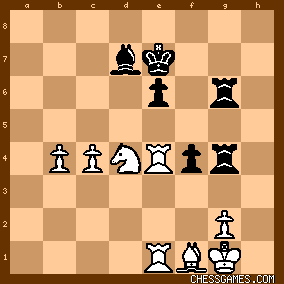
click for larger viewIf this were a fight, it would have been stopped. Lasker had an extra piece, and extra pawn, and a host of threats. Marshall had...nothing. But yet, he played on. 42... Kd6
Deciding to walk into a mating net. Lasker was fine with this. 43. c5+ Kd5
Playing for help-mate. 43...Kc7 or 43...Ke7 might have allowed Marshall to prolong the game a bit, though why he would want to escapes me. 44. Nf3 Rf6
44...Kc6 was the only way to extend the game for even a few moves. Now, Lasker snapped the mating net shut on Marshall, the position now being: 
click for larger view45. Rd4+
45. Ne5 (precluding Kc6) was even faster.
45... Kc6
46. Ne5+
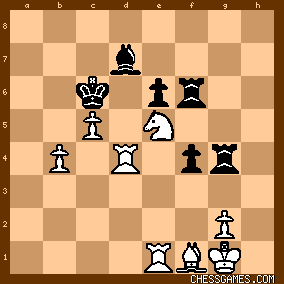
click for larger view1-0
Facing the loss of another piece followed by mate, Marshall finally lowered his flag. |
|
|
|
|





































